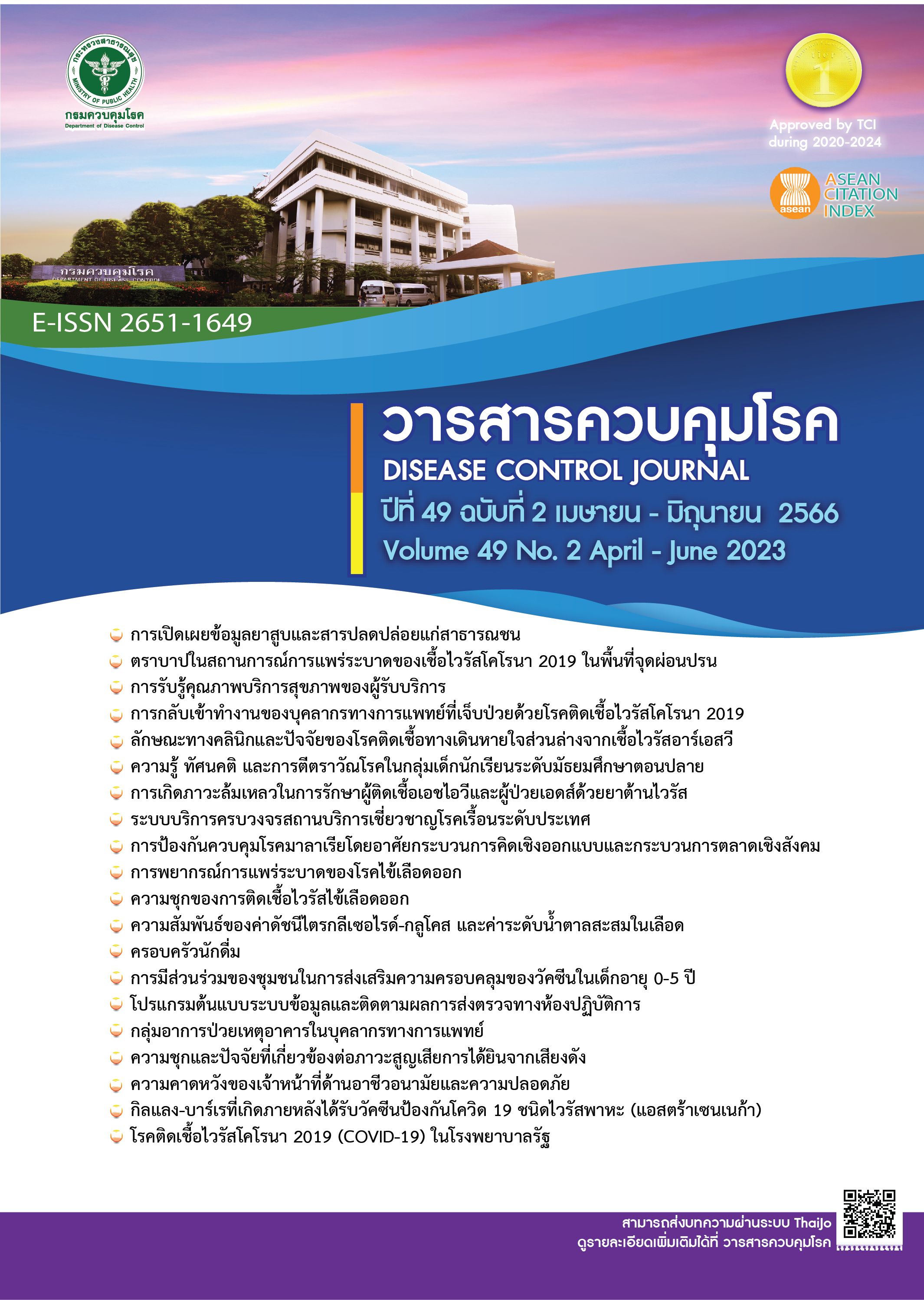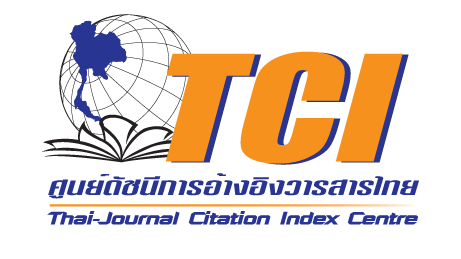Seroprevalence of Dengue virus infection among Thai population
DOI:
https://doi.org/10.14456/dcj.2023.31Keywords:
Prevalence of dengue infection, Dengue seroprevalence, Dengue virus infection, DengueAbstract
Dengue is one of the most important public health threats. The World Health Organization has set a goal to reduce mortality and morbidity from dengue by 2020 by at least 50% and 25 % respectively (using 2010 as the baseline), and has recommended using a vaccine against dengue fever in the population if the prevalence of dengue virus infection in children over 9 years old (sp9) is greater than 80%. This study aims to determine the prevalence and related factors of dengue infection rates in the population of 2-69 years old in 4 provinces from 4 regions: Nonthaburi, Phitsanulok, Udon Thani, and Surat Thani Province. Blood samples were collected from the blood bank or from clinical laboratory examinations of patients, and tested for dengue immunity (IgG) with an ELISA. Of those 1,580 volunteers, 54.5% were males and 56.1% lived in urban area. Findings reveal that 57% of the population studied (901/1,580) were infected with dengue and 59.4% of 9-year-old children (38/64) were infected. The prevalence of dengue virus infection rate was 32.9% (95% CI, 30.8-35.0) in children aged 2-5 years old, 46.6% (95% CI, 46.2-47.1) in children aged 6-9 years old, and 55.4% (95% CI, 54.3-56.4) in 10-14 years old age group, while the prevalence among 20-year and older age groups were higher than 80%. An increased age group showed an increased risk of infection by 4.45 times (OR, 95% CI, 3.84-5.17) and living in the different regions had different infection rates. However, genders or living areas (urban or out-of-town) were not statistically significantly associated with the infection rate. Therefore, the vaccine against dengue should be recommended for the age groups of 20 years and older. For the vaccine recipient under the age of 20, it is essential to check for viral infection or immunity before to vaccination. However, other measures including vector control, vector surveillance, and disease surveillance remain critical that must be conducted continuously to limit the transmission as well as to reduce illness and death from dengue.
Downloads
References
Gibbons RV, Vaughn DW. Dengue: an escalating problem. BMJ. 2002;324(7353):1563-6.
World Health Organization. Dengue and severe dengue (Factsheet) [Internet]. 2020 [cited 2021 Mar 21]. Available from: https://www.who.int/news-room/fact-sheets/detail/dengue-and- severe-dengue
Bhatt S, Gething PW, Brady OJ, Messina JP, Farlow AW, Moyes CL, et al. The global distribution and burden of dengue. Nature. 2013; 496(7446):504-7.
Stanaway JD, Shepard DS, Undurraga EA, Halasa YA, Coffeng LE, Brady OJ, et al. The global burden of dengue: an analysis from the Global Burden of Disease Study 2013. Lancet Infect Dis. 2016;16(6):712-23.
Wilder-Smith A, Gubler DJ, Weaver SC, Monath TP, Heymann DL, Scott TW. Epidemic arboviral diseases: priorities for research and public health. Lancet Infect Dis. 2017;17(3) :e101-e6.
L’Azou M, Assoukpa J, Fanouillere K, Plennevaux E, Bonaparte M, Bouckenooghe A, et al. Dengue seroprevalence: data from the clinical development of a tetravalent dengue vaccine in 14 countries (2005-2014). Trans R Soc Trop Med Hyg. 2018;112(4):158-68.
Gubler DJ. Dengue and Dengue Hemorrhagic Fever: Clinical Microbiology Reviews. 1998;July:480-96.
Rodriguez-Barraquer I, Buathong R, Iamsirithaworn S, Nisalak A, Lessler J, Jarman RG, et al. Revisiting Rayong: shifting seroprofiles of dengue in Thailand and their implications for transmission and control. Am J Epidemiol. 2014;179(3):353-60.
World Health Organization. Global Strategy for Dengue Prevention and Control 2012-2020 [Internet]. Geneva; 2012 [cited 2018 Jun 26]. Available from: https://reliefweb.int/sites/reliefweb.int/files/resources/9789241504034_eng.pdf
Division of Vector Borne Disease, Department of Disease Control (TH). Dengue: Forecasting report 2020 [Internet]. [cited 2021 Oct 4]. Available from: http://nont-pro.go.th/public/news_upload/backend/files_306_1.pdf
Gubler DJ. Dengue, Urbanization and Globalization: The Unholy Trinity of the 21st Century. Trop Med Health 2011;39(4 Suppl):3-11.
Simmons CP, Farrar JJ, Nguyen vV, Wills B. Dengue. N Engl J Med. 2012;366(15):1423-32.
Ferguson RW, Henderson SJ, Lee EA, Jung P. Dengue in Peace Corps Volunteers, 2000-14. J Travel Med. 2016;23(3):1-4.
Editorial. Infectious disease crisis in the Philippines. Lancet Infect Dis. 2019;19(12):1265.
World Health Organization. Meeting of the Strategic Advisory Group of Experts on immunization, April 2016-conclusions and recommendations. Dengue vaccine: Weekly epidemiological record. 2016;21:282-4.
World Health Organization. Dengue vaccine: WHO position paper-July 2016: Weekly epidemiological record. 2016;91(30):349-64.
Hadinegoro SR, Arredondo-Garcia JL, Capeding MR, Deseda C, Chotpitayasunondh T, Dietze R, et al. Efficacy and Long-Term Safety of a Dengue Vaccine in Regions of Endemic Disease. N Engl J Med. 2015;373(13):1195-206.
Villar L, Dayan GH, Arredondo-Garcia JL, Rivera DM, Cunha R, Deseda C, et al. Efficacy of a tetravalent dengue vaccine in children in Latin America. N Engl J Med. 2015;372(2):113-23.
World Health Organization. Dengue vaccine: WHO position paper-September 2018: Weekly epidemiological record. 2018;93(30):457-76.
Sridhar S, Luedtke A, Langevin E, Zhu M, Bonaparte M, Machabert T, et al. Effect of Dengue Serostatus on Dengue Vaccine Safety and Efficacy. N Engl J Med. 2018;379(4):327-40.
Nascimento EJM, George JK, Velasco M, Bonaparte MI, Zheng L, DiazGranados CA, et al. Development of an anti-dengue NS1 IgG ELISA to evaluate exposure to dengue virus. J Virol Methods. 2018;257:48-57.
Wilder-Smith A, Flasche S, Smith PG. Vaccine-attributable severe dengue in the Philippines. Lancet. 2019;394(10215):2151-2.
Prompetchara E, Ketloy C, Thomas SJ, Ruxrungtham K. Dengue vaccine: Global development update. Asian Pac J Allergy Immunol. 2020;38(3):178-85.
Suangtho P. Dengue diseases (Dengue fever, Dengue hemorrhagic fever, Dengue shock syndrome). In: Yingyong T, editor. Annual Epidemiological Surveillance Report 2019. Nonthaburi: Department of Disease Control (TH); 2020. p. 41-5. (In Thai)
Limkittikul K, Brett J, L’Azou M. Epidemiological trends of dengue disease in Thailand (2000-2011): a systematic literature review. PLoS Negl Trop Dis. 2014;8(11):e3241.
Whitehead SS, Blaney JE, Durbin AP, Murphy BR. Prospects for a dengue virus vaccine. Nat Rev Microbiol. 2007;5(7):518-28.
Murphy BR, Whitehead SS. Immune response to dengue virus and prospects for a vaccine. Annu Rev Immunol. 2011;29:587-619.
Cummings DA, Iamsirithaworn S, Lessler JT, McDermott A, Prasanthong R, Nisalak A, et al. The impact of the demographic transition on dengue in Thailand: insights from a statistical analysis and mathematical modeling. PLoS Med. 2009;6(9):e1000139.
Lee JS, Lourenco J, Gupta S, Farlow A. A multi-country study of dengue vaccination strategies with Dengvaxia and a future vaccine candidate in three dengue-endemic countries: Vietnam, Thailand, and Colombia. Vaccine. 2018;36(17):2346-55.
Vongpunsawad S, Intharasongkroh D, Thongmee T, Poovorawan Y. Seroprevalence of antibodies to dengue and chikungunya viruses in Thailand. PLoS One. 2017;12(6):e0180560.
Doum D, Overgaard HJ, Mayxay M, Suttiprapa S, Saichua P, Ekalaksananan T, et al. Dengue Seroprevalence and Seroconversion in Urban and Rural Populations in Northeastern Thailand and Southern Laos. Int J Environ Res Public Health. 2020;17(23):1-19.
Vandepitte WP, Chaweethamawat A, Yoksan S. Seroprevalence of Neutralizing Antibody Against Dengue Virus in Health Care Worker in Bangkok Thailand. Southeast Asian J Trop Med Public Health. 2019;50(5):816-24.
Tuntaprasart W, Barbazan P, Nitatpattana N, Rongsriyam Y, Yoksan S, Gonzalez JP. Seroepidemiological survey among schoolchildren during the 2000-2001 dengue outbreak of Ratchaburi Province, Thailand. Southeast Asian J Trop Med Public Health. 2003;34(3):564-8.
Alera MT, Srikiatkhachorn A, Velasco JM, Tac-An IA, Lago CB, Clapham HE, et al. Incidence of Dengue Virus Infection in Adults and Children in a Prospective Longitudinal Cohort in the Philippines. PLoS Negl Trop Dis. 2016;10(2):e0004337.
McBride WJ, Mullner H, LaBrooy JT, Wronski I. The 1993 dengue 2 epidemic in North Queensland: a serosurvey and comparison of hemagglutination inhibition with an ELISA. Am J Trop Med Hyg. 1998;59(3):457-61.
Dhar-Chowdhury P, Paul KK, Haque CE, Hossain S, Lindsay LR, Dibernardo A, et al. Dengue seroprevalence, seroconversion and risk factors in Dhaka, Bangladesh. PLoS Negl Trop Dis. 2017;11(3):e0005475.
Dhanoa A, Hassan SS, Jahan NK, Reidpath DD, Fatt QK, Ahmad MP, et al. Seroprevalence of dengue among healthy adults in rural community in Southern Malaysia: a pilot study. Infect Dis Poverty. 2018;7(1):1.
Pavia-Ruz N, Diana Patricia R, Salha V, Granja P, Balam-May A, Longini IM, et al. Seroprevalence of Dengue Antibodies in Three Urban Settings in Yucatan, Mexico. Am J Trop Med Hyg. 2018;98(4):1202-8.
Fox-Lewis A, Hopkins J, Sar P, Sao S, Pheaktra N, Day NPJ, et al. Seroprevalence of Dengue Virus and Rickettsial Infections in Cambodian Children. Am J Trop Med Hyg. 2019;100(3) :635-8
Fritzell C, Rousset D, Adde A, Kazanji M, Van Kerkhove MD, Flamand C. Current challenges and implications for dengue, chikungunya and Zika seroprevalence studies worldwide: A scoping review. PLoS Negl Trop Dis. 2018;12(7):e0006533.
Downloads
Published
How to Cite
Issue
Section
License
Copyright (c) 2023 Disease Control Journal

This work is licensed under a Creative Commons Attribution-NonCommercial-NoDerivatives 4.0 International License.
Articles published in the Disease Control Journal are considered as academic work, research or analysis of the personal opinion of the authors, not the opinion of the Thailand Department of Disease Control or editorial team. The authors must be responsible for their articles.






